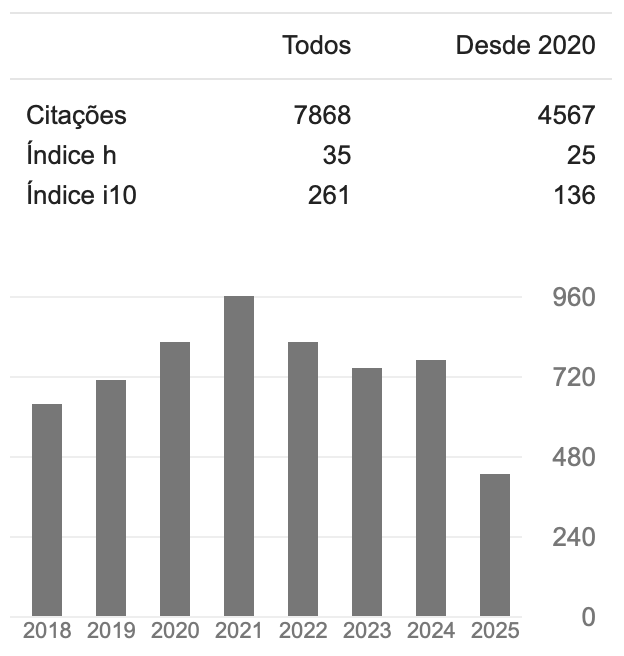A topografia da audição de vozes: uma possibilidade de interpretação da linguagem da subjetividade
DOI:
https://doi.org/10.17765/1983-1870.2018v11n3p555-565Palavras-chave:
Alucinações, Linguagem, TopografiaResumo
A topografia das alucinações consiste na exploração de suas características. Este estudo objetivou analisar variáveis topográficas de vozes alucinatórias de frequentadores de um Centro de Atenção Psicossocial. Para isso, dez pessoas foram entrevistadas e tiveram seus relatos analisados pela Análise de Conteúdo. As variáveis encontradas foram: “intensidade”, “frequência”, “quantidade”, “conteúdo”, “identidade”, “gênero”, “forma como se apresentam”, “valência emocional”, e “nível de influência”. As vozes chegam a ser tão intensas que provocam estados dissociativos. As variáveis “frequência” e “quantidade” foram heterogêneas, e podem estar relacionadas à trajetória biográfica. O conteúdo diz respeito a questões estruturantes da vida dos entrevistados e que causam muitos conflitos. Cinco participantes afirmaram que as vozes eram de pessoas conhecidas, e sete conseguiam diferenciar o gênero. As vozes de comando foram as mais frequentes, e levaram alguns deles à tentativas de suicídio. Concluiu-se que a exploração das variáveis topográficas das vozes pode auxiliar a compreensão do fenômeno.Downloads
Referências
Styron T, Utter L, Davidson L. The hearing voices network: initial lessons and future directions for mental health professionals and systems of care. Psychiatr Q. 2017 Dec;88(4):769-85.
Hugdahl K, Sommer I.E. Auditory Verbal Hallucinations in Schizophrenia from a Levels of Explanation Perspective. Schizoph Bull. 2017;44(2):234-241.
McCarthy-Jones S. Can’t You Hear Them?: The Science and Significance of Hearing Voices. Jessica Kingsley Publishers; 2017.
Vilhauer RP, Sharma H. Unsolicited reports of voice hearing in the general population: a study using a novel method. Psychosis. 2018;1-12.
Waters F, Blom JD, Jardri R, Hugdahl K, Sommer I.E.C. Auditory hallucinations, not necessarily a hallmark of psychotic disorder. Psychol Med. 2018;48(4): 529-36.
Wilkinson S, Bell V. The representation of agents in auditory verbal hallucinations. Mind & Language. 2016;31(1):104-26.
Corstens D, Longden E, McCarthy-Jones S, Waddingham R, Thomas N. Emerging perspectives from the hearing voices movement: implications for research and practice. Schizophr Bull. 2014 jul;40(4 Suppl):S285–94.
Soppitt W, Birchwood M. Depression, beliefs, voice content and topography: A cross-sectional study of schizophrenic patients with auditory verbal hallucinations. Journal of Mental Health. 1997;6(5):525-32. p. 525.
Escher S. Making sense of voices: the relationship between the voices and the life history. In: Romme M, Escher S, Dillon J, Corstens D, Morris M. Living with voices: 50 stories of recovery. Birmingham City University: PCCS Books; 2009. p. 54-62.
McCarthy-Jones S, Thomas N, Strauss C, Dogdson G, Jones N, Woods, et al. Better than mermaids and stray dogs? Subtyping auditory verbal hallucinations and its implications for research and practice. Schizophr Bull 2014;40(4 Suppl):S275–84.
Ruddle A, Livingstone S, Huddy V, Johns L, Stahl D, Wykes T. A case series exploring possible predictors and mechanisms of change in hearing voices groups. Psychol Psychother. 2014;87(1):60-79.
Zanello A, Mohr S, Merlo MC, Huguelet P, Rey-Bellet P. Effectiveness of a brief group cognitive behavioral therapy for auditory verbal hallucinations: a 6-month follow-up study. J Nerv Ment Dis. 2014 Feb;202(2):144-53.
Chiang YH, Beckstead JW, Lo SC, Yang CY. Association of auditory hallucination and anxiety symptoms with depressive symptoms in patients with schizophrenia: a three-month follow-up. Arch Psychiatr Nurs. No prelo 2018.
Bardin L. Análise de conteúdo. São Paulo: Edições 70;2016.
Coleman R, Smith M. Working with voices II: Victim to victor. Fife, Scotland: P&P Press; 2005.
Escher S, Hage P, Romme M. Voice hearing: a questionnaire. 2011. [acesso em 2017 Jun 18]. Disponível em: http://www.hearingvoices.org.nz
Baker P. The voice inside: a practical guide for and about people who hear voices. Port of Ness: P&P Press; 2009.
Caplan G. Principios de la psiquiatria preventiva. Buenos Aires: Ed Paidós; 1966.
Corstens D, Longden E. The origins of voices: links between life history and voice hearing in a survey of 100 cases. Psychosis. 2013;5(3):270-85.
Longden E, Waterman A.M.M.G. Dissociation, trauma, and the role of lived experience: toward a new conceptualization of voice hearing. Psychol Bull. 2012;138(1): 28–76.
Zanello V. Saúde mental, gênero e dispositivos: cultura e processos de subjetivação. Curitiba: Appris; 2018.
Perona-Garcelán S, Pérez-Álvarez M, García-Montes JM, Cangas AJ. Auditory Verbal Hallucinations as Dialogical Experiences. Journal of Constructivist Psychology, 2015;28(3):264-280.
Waiselfisz JJ. Mapa da violência 2015: homicídios de mulheres no Brasil. Brasília: FLACSO Brasil. 2015. [acesso em 2017 Jul 7]. Disponível em: http://www.mapadaviolencia.org.br/
Osorio RG, Fontoura N. Tolerância social à violência contra as mulheres. Brasília: IPEA. 2014. [acesso em 2017 Jul 7]. Disponível em: https://ipea.gov.br/portal
Peters ER, Williams SL, Cooke MA, Kuipers E. It’s not what you hear, it’s the way you think about it: appraisals as determinants of affect and behaviour in voice hearers. Psychol Med. 2012;42(7): 1507-1514.
Thomas N, Farhall J, Shawyer F. Beliefs about voices and schemas about self and others in psychosis. Behav. Cogn. Psychother. 2015;43(2):209-223.
Badcock JC, Chhabra S. Voices to reckon with: perceptions of voice identity in clinical and non-clinical voice hearers. Frontiers in Human Neuroscience. 2013;7(114):40-8.
Johns L, Kompus K, Connell M, Humpston C, Lincoln T, Longden E, et al. Auditory verbal hallucinations in persons with and without a need for care. Schizophr Bull 2014;40(4 Suppl):S255-S264. p. S255.
Minkowski E. Breves reflexões a respeito do sofrimento (aspecto pático da existência). Rev. latinoam. psicopatol. fundam. 2000 out/dez;3(4):156-64.
Kalhovde AM, Elstad I, Talseth AG. Understanding the experiences of hearing voices and sounds others do not hear. Qualitative Health Research. 2013;23(11): 1470-80.
Downloads
Publicado
Como Citar
Edição
Seção
Licença
A submissão de originais para a revista Saúde e Pesquisa implica na transferência da Carta Concessão de Direitos Autorais, pelos autores, dos direitos de publicação digital para a revista após serem informados do aceite de publicação.A Secretaria Editorial irá fornecer da um modelo de Carta de Concessão de Direitos Autorais, indicando o cumprimento integral de princípios éticos e legislação específica. Os direitos autorais dos artigos publicados nesta revista são de direito do autor, com direitos da revista sobre a primeira publicação. Os autores somente poderão utilizar os mesmos resultados em outras publicações, indicando claramente a revista Saúde e Pesquisa como o meio da publicação original. Em virtude de tratar-se de um periódico de acesso aberto, é permitido o uso gratuito dos artigos, principalmente em aplicações educacionais e científicas, desde que citada a fonte. A Saúde e Pesquisa adota a licença Creative Commons Attribution 4.0 International.
A revista se reserva o direito de efetuar, nos originais, alterações de ordem normativa, ortográfica e gramatical, com vistas a manter o padrão culto da língua e a credibilidade do veículo. Respeitará, no entanto, o estilo de escrever dos autores. Alterações, correções ou sugestões de ordem conceitual serão encaminhadas aos autores, quando necessário. Nesses casos, os artigos, depois de adequados, deverão ser submetidos a nova apreciação. As opiniões emitidas pelos autores dos artigos são de sua exclusiva responsabilidade.


















